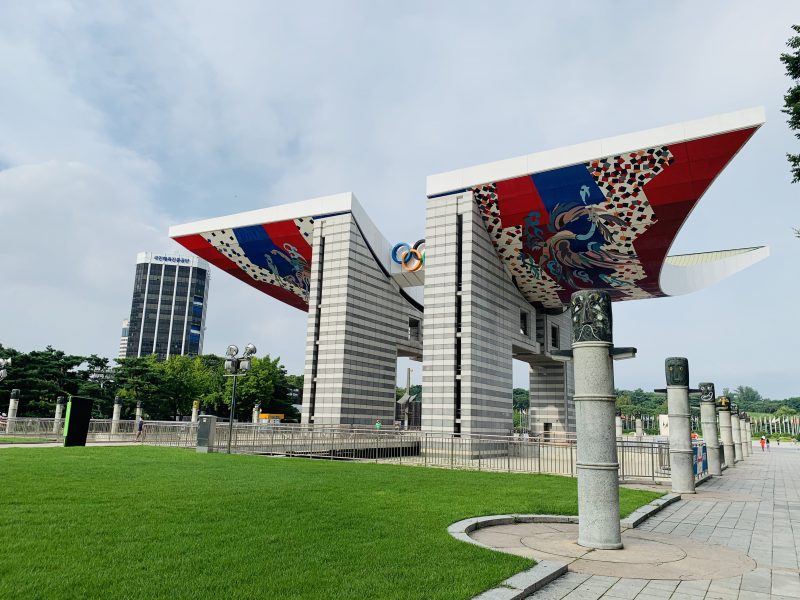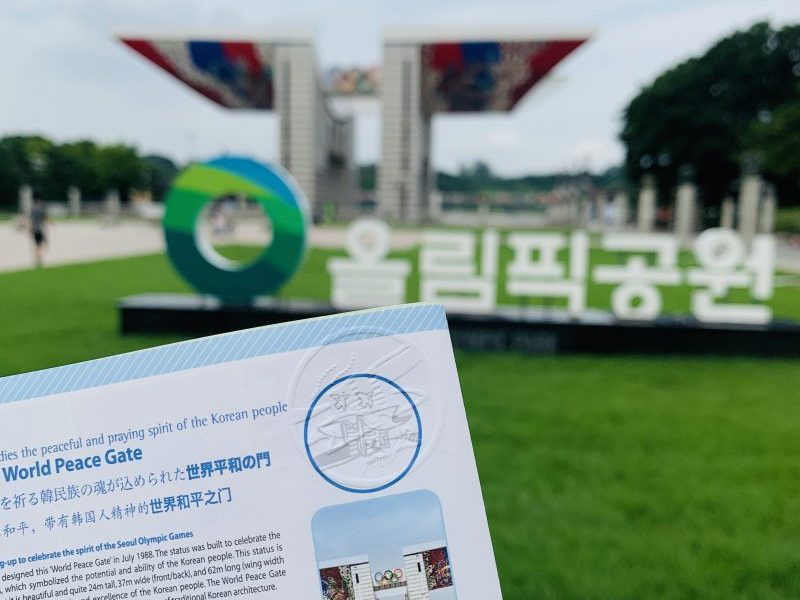Whether you’re a fan of the Olympics or love nature, there’s one place sure to take your breath away. And just in case you haven’t guessed it by now, we’re referring to the modern metropolis’ hidden jewel. Yes, the Seoul Olympic Stadium is one of the city’s most treasured destinations.
While serving as the mainstay venue for the 10th Asian Games in 1986, this beauty is more than meets the eye. Moreover, the name can be deceiving. And that’s because it’s not solely restricted for those who share a soft corner for sports.

You’ll find families with kids strolling around peacefully. On the other end, there’s plenty of date spots for couples in search of a blissful atmosphere. But that’s just the beginning.
Likewise, there’s a lot more exploration that awaits visitors. And below, we’re covering it all just for you.
From the rich background to the architectural design and other places that warrant a visit, we’re unraveling it all.
The centerpiece of Seoul’s Sports Complex

Situated in the Songpa District, the Seoul Olympics Stadium is Seoul’s Sports Complex’s main feature. Similarly, it is owned and operated under the city’s Sports Facilities Management Center.
Seoul Olympic Stadium’s construction started in 1977. Here, the ultimate aim was to stage the 1986 Asian Games. Therefore, it was inaugurated on 29th September 1984.
Since then, it has won hearts with its unique architectural design. However, don’t be too surprised there. And that’s because construction estimates go as high as 491 billion won. Now that’s one pricey investment.
Multi-purpose stadium with great design

Coming to the stadium’s layout, there’s a lot of thought that’s gone into its architecture. Originally designed by Kim Swoo-geun, it’s a breathtaking affair.
Similarly, it’s not uncommon to find lines in the profile that imitate the sophisticated curves of ancient Korean pottery. In particular, a lot of inspiration was taken from porcelain vases that belong to the Joseon Dynasty.
With a field size surmounting to 110 x 75m, it holds the capacity to host up to 69,950 individuals. Furthermore, it’s not uncommon to see the stadium filled with grass. But you’ll find quite a bit of leveled concrete ground around the premises too.
Today, it continually attracts millions from all around the world, hosting a number of world class sporting events.
Arriving at Seoul Olympic Stadium

First things first, how do you get there? With Seoul’s metro hustling and bustling as the ideal form of transport, you can easily reach via a metro. The Mongchontoseong Station, present on Line 8, will lead you directly to the stadium via the famous World Peace Gate.
Peace Gate- a heartwarming welcome

Designed to captivate your senses at first glance, this gate has all the elements to make you feel special. The 24m high colorful entrance is a symbol of peace and harmony for sports games. And the fact that it took 20 months to build shows in its versatility.
Some common architectural highlights include the Entrance plaza with its patterned flooring. Let’s not forget the many paintings and sculptures, combined with different posts of flags too.
All in all, it’s safe to say that there’s no better way to feel welcomed than this.
Stamp tour at Seoul Olympic Stadium

Before you get amazed by the sea of green in this massive concrete jungle, a stamp tour awaits you.
This was created as a fun-filled activity for visitors. Moreover, it encourages people to win free gifts while exploring the giant venue. Simply collect a map from the information desk and wander away in search of 9 hidden attractions. At the end of the hunt, you can claim your prize by showing your stamped map.
The Thumb Sculpture

Built-in 1988, one of the Seoul Olympic Stadium’s rather unique findings is a giant thumb sculpture. This art feature definitely takes many visitors by surprise. Nevertheless, it’s intricate detailing and massive size serves as an ideal tourist attraction for memorable photographs.
The entire stadium’s premises is full of over 200 jaw dropping sculptures. And it’s needless to say they’re scattered beautifully across the most luscious sprawling lawns.
88 Lake at Seoul Olympic Stadium

Who knew an artificial lake could look this glamorous? Lake 88 is another popular tourist spot for those in search of serene beauty. It wouldn’t be wrong to term it as a wanderlust for the senses. Surrounded by 13 sculptures, you can’t help but soak in nature’s finest offerings. And just in case that wasn’t enough, there’s plenty of fresh greenery too.
Sculpture of Communication- legacy comes home

You simply can’t get enough of magnificent art pieces around the stadium. And another fabulous example is the Sculpture of Communication. This was made by a famed Algerian artist, Mohand Amara.
Designed in 1987, it’s a versatile piece that carries all the elements of innovation. Moreover, it symbolizes the legacy of the 1988 Olympics.

Keeping in mind the artist’s thought process, this sculpture stands for the value of dialogue in overcoming barriers. After all, communication is key.
Other than that, how long does it actually take to explore? Well, make sure you have several hours to spare. The stadium is vast and you need to enjoy, every step of the way. Don’t forget those comfy shoes. They do wonders with all the walking around.
Last but not least, seeing animals are another added bonus on your trip through the park. If you’re lucky, you’ll find rabbits, ducks, and pheasants too.
Other Interesting Facts
If you think sports and sculptures are the only fascinations, you’re wrong. The giant complex also features entertainment. Yes, you can get tickets for musical concerts too. Just be sure to book in advance. And then avail the fun with loved ones. But where are these held? The giant arena for gymnastics plays host and rightly so.

With so many iconic landmarks and an outdoor recreational facility, Seoul Olympic Stadium deserves a special spot on the bucket list. And it’s no wonder why millions of tourists pay a visit each year.
If you plan on visiting Seoul for a day, don’t forget to check out this fabulous one-day itinerary.


